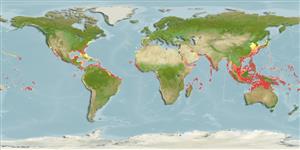Teleostei (teleosts) >
Tetraodontiformes (Puffers and filefishes) >
Balistidae (Triggerfishes)
Etymology: Canthidermis: Greek, kanthos = the outer or inner corner of the eye, where the lids meet, 1646 + Greek, derma = skin (Ref. 45335).
More on author: Bloch.
Environment: milieu / climate zone / depth range / distribution range
Ecology
Marine; reef-associated; depth range 1 - 110 m (Ref. 9710). Subtropical; 46°N - 18°S
Circumglobal in warm and tropical seas (not in the Mediterranean).
Size / Weight / Age
Maturity: Lm ? range ? - ? cm
Max length : 50.0 cm TL male/unsexed; (Ref. 9276); common length : 35.0 cm TL male/unsexed; (Ref. 55763)
Found in shallow coastal and offshore waters (Ref. 9276, 11230). Epipelagic nearly all throughout life, often associated with drifting objects (Ref. 1602, 44187). May occur on deep rocky slopes (Ref. 7251). Feeds on zooplanktons (Ref. 89972). Appear to school in large numbers based on catches from set nets (Ref. 637). Oviparous (Ref. 205). Marketed fresh (Ref. 9770).
Life cycle and mating behavior
Maturities | Reproduction | Spawnings | Egg(s) | Fecundities | Larvae
Distinct pairing (Ref. 205).
Myers, R.F., 1991. Micronesian reef fishes. Second Ed. Coral Graphics, Barrigada, Guam. 298 p. (Ref. 1602)
IUCN Red List Status (Ref. 130435)
Threat to humans
Reports of ciguatera poisoning (Ref. 30911)
Human uses
Fisheries: commercial
Tools
Special reports
Download XML
Internet sources
Estimates based on models
Preferred temperature (Ref.
123201): 23 - 29, mean 27.7 °C (based on 2250 cells).
Phylogenetic diversity index (Ref.
82804): PD
50 = 0.6250 [Uniqueness, from 0.5 = low to 2.0 = high].
Bayesian length-weight: a=0.02570 (0.01232 - 0.05364), b=2.94 (2.77 - 3.11), in cm total length, based on LWR estimates for this (Sub)family-body shape (Ref.
93245).
Trophic level (Ref.
69278): 3.5 ±0.45 se; based on food items.
Resilience (Ref.
120179): Medium, minimum population doubling time 1.4 - 4.4 years (Preliminary K or Fecundity.).
Fishing Vulnerability (Ref.
59153): Moderate vulnerability (40 of 100).
Nutrients (Ref.
124155): Calcium = 19.1 [7.1, 65.2] mg/100g; Iron = 0.52 [0.26, 1.25] mg/100g; Protein = 19.1 [17.0, 21.3] %; Omega3 = 0.177 [0.095, 0.338] g/100g; Selenium = 20.9 [9.2, 45.4] μg/100g; VitaminA = 28.6 [7.3, 120.0] μg/100g; Zinc = 0.609 [0.392, 0.961] mg/100g (wet weight);
